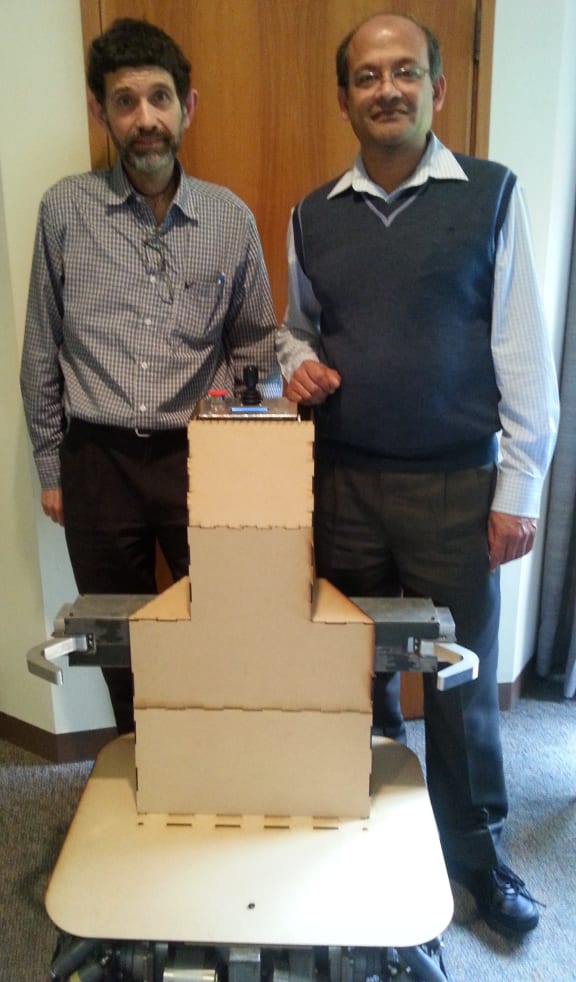by Ruth Beran
With hospital beds weighing in the order of 300kg, or up to 350 or 400kg with a patient on top, it can be hard work to move them. The process usually takes two people, and injuries can sometimes occur, particularly where beds are being moved down narrow corridors and one person has to face backwards.
At Massey University, a machine has been developed to move hospital beds which only requires one person to manoeuvre the bed by moving a joystick.
“There’s been a number of systems developed for moving beds, a lot of them require one unit per bed, to be built into the bed, and of course that’s fairly expensive,” says mechatronic engineer Ken Mercer. “[Our] approach was to have one machine, a fairly complicated machine, which could grip hold of virtually any bed, and then move it.”

Ken Mercer and Gourab Sen Gupta with the hospital bed mover Photo: RNZ / Ruth Beran
The prototype machine has a central console which reaches to just above waist height, and has two grippers on either side to grip hold of the end of the bed.
“At the press of a button, these grippers open, and once you have this machine in place, you close the gripper, it will grab the footboard of the hospital bed,” says mechatronic engineer Gourab Sen Gupta. “Thereafter it’s just a matter of using a joystick and you can move the bed together with this mover.”
The machine moves smoothly in four directions, left, right, forwards and backwards, and can also rotate. It uses four Mecanum wheels which allow the machine to move sideways like a crab. “They do look like a normal wheel but there are wheels within a wheel. You can see there are lots of rollers, and these rollers are at a particular angle,” says Gourab.
“The key is the rollers are not directly across the wheels but they’re at a 45˚ angle,” says Ken, “As the wheel rotates, if it were directly across they’d just spin and nothing would happen, but because they’re at an angle it gives the robot the ability to move sideways or forwards or backwards or rotate.”
The machine also has several sensors built in, one of which senses when the headboard of the bed has been gripped and stops if the gripping force is tight enough.
A microcontroller also controls the power to the motor to ensure the machine moves at a very controllable speed. One minicomputer controls the movement of the wheels, and another controls the grippers. The software for these minicomputers was developed by the team.
The hospital bed mover is battery operated and has a small display to indicate status messages, like battery levels, and when the grippers are being opened. Being battery operated, it can’t give electric shocks, and the battery lasts for about a day, enabling 20 or 30 beds to be moved before needing to be recharged.
The machine incorporates safety features like automatically limiting the speed of the machine to about 2 km/h. “Even if you try to move faster than this, the system will not allow it to happen,” says Gourab. Also if an inclination is too large, for example more than 1:12, the software cuts off the wheels, and the machine stops. “The idea here is you don’t want to run away with the hospital bed, especially with the patient on top of it,” says Gourab.
The machine took a Masters student about a year to build, but further field trials will be needed to commercialise the machine. The machine will also need to have an outer cover which meets hygiene standards for a hospital, at the moment the electronics are exposed at the back.
So far though, Gourab says feedback has been positive. “We have had field trials in what used to be the Aorangi Hospital, and within like 20 – 30 minutes, we have had nurses enjoying -- I would say --moving hospital beds,” says Gourab.
In the future, the team would like to have a machine that would come when called, turning up where needed. “But at that point, there’s a lot of safety devices needed if it’s going to roam a hospital on its own and that’s just not feasible for a while. So long as someone’s walking behind it it’s relatively safe,” says Ken.
The hospital bed mover does have an emergency stop button, which can be pressed to stop the machine. “It’s never been used, but it was built in there at the start just to be safe,” says Ken.
The hospital bed mover will cost about $20,000 or $25,000.
“A hospital with probably 100 to 150 beds, would require no more than two of these units. So it’s an investment of like $50,000 but I think the hospitals will recover this cost in less than a year,” says Gourab.
“It’s not just the manpower cost of hiring a nurse, it’s the cost of treating nurses when they get hurt. So that is a substantial cost which can be saved,” says Gourab.

